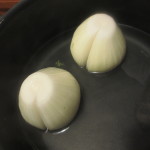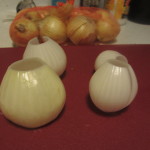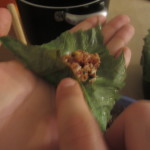A few weeks ago, I was staring out my window, admiring the not so lovely view of my apartment’s dilapidated parking lot. As I scanned the tree covered lot (the verdure is the only redeeming quality of the parking lot), I noticed that there were grape leaves growing along one side of the lot. I made a mental note that at some point in the upcoming weeks, I would need to pick a bunch of grape leaves to make dolma. Two weeks later, as I was walking back from work, I decided that it was time pick grape leaves. With my work bag on one shoulder, and my lunch bag hanging from my other arm, I got to work. One of my friends, also a neighbor, who had just returned from work, stopped to ask me what I was doing. I showed her the leaves and explained my grand plan. My roommate, also returning from work, saw me in the parking lot. When I showed her my exciting green leafy treasure, she laughed, and told me it was exactly something her grandmother would do, but with other herbs. I guess I’ve already got the beginnings of grandmotherly behavior. When I collected a decent amount of grape leaves, I sent a picture of them to my brother, who kindly offered to come over and help me wrap dolma. He stopped by a few days later, and we made an evening out of it – wrapping dolma, teaching my roommate how to wrap dolma, and telling stories. A perfect evening indeed.
Dolma was practically a staple food growing up. My brother and I used to spend our summers with Nana, my grandmother on my dad’s side. She would often make dolma for us. Not spicy, and daintly wrapped, Nana is dolma pro. Each time we ate dolma, we requested a bowl of lemondoozi (ctiric acid) with water. My brother and I were crazy for all things sour, and we loved dipping the dolma into a bowl of lemondoozi. Nana thought we were crazy, but we loved it. And, when we were done eating our dolma, we would drink the lemondoozi that now resembled a stew of rice, beef, and grape leaves. (We weren’t the neatest eaters around).
I’ve never made dolma on my own. I’ve helped my mom make it, and I’ve watched my grandparents make it numerous times. When I was younger, my brother and I would come home from school to find my grandparents in the kitchen, making dolma. Still in our uniforms, my brother and I would wash our hands and sit at the kitchen table, eager to help, but afraid to ruin the delicate tarpeh (grape leaves). My grandparents would carefully demonstrate how to wrap an individual tarpeh (grape leaf), and how to stuff an onion, tomato, or pepper. In good spirits, they would laugh at our clumsy attempts to wrap dolma. My grandmother, whom we called Grama, would often unwrap our sad attempts and demonstrate, for the hundredth time, how to correctly wrap the tarpeh. I know she would be proud of this dolma, that I picked the grape leaves on my own, and that my brother and I made it together. I know she would have plenty of stories to recount, narrating the first time she made dolma, and detailing her process for picking, cleaning, and storing grape leaves.
Notes: You should have equal parts rice and meat for the dolma stuffing. The number of grape leaves you need will depend on the size of the grape leaves that you have. Dolma is very flexible. You can chop whatever veggies you like into the stuffing, and you can stuff your favorite veggies (jalapenos, peppers, onions…etc.)
Ingredients
Grape leaves
The Filling
1 lb beef chuck (2 cups finely chopped)
2 cups white rice
3 tablespoons baharat
1.5 teaspoons salt
1 teaspoon black pepper
2 tablespoons lemon juice
1 can tomato paste
1/2 cup tomato sauce
1 medium onion, finely chopped
1 jalapeno, finely chopped, seeds removed (optional)
1/2 green pepper, finely chopped (optional)
Vegetables to Stuff
2 medium onions, for stuffing (optional)
3 tomatoes, for stuffing (optional) (longer tomatoes, like roma tomatoes)
1 zucchini, for stuffing (optional)
Cooking the Dolma
2-3 cups water (warm enough to dissolve the citric acid)
1/4 cup oil
2 tablespoons lemondoozi (citric acid)
*lemon juice is an alternative
Directions
Preparing the filling
Chop the meat into very small cubes and place in a bowl. Finely chop the onion and green pepper. Add them to the bowl with chopped meat.
Wash 2 cups of white rice and add it to the meat and chopped vegetables.
Slice the tops of the tomatoes. Take a paring knife and hollow out the three tomatoes. Chop the tomato filling and add it to the bowl with chopped meat and veggies.
Peel the two onions. Make a longitudinal slit into the onion, from top to bottom. The slit should stop at the onion core – do not cut the onion in half. Fill a bowl about an inch with boiling water. Place the onions in the water, and let them sit for a few minutes. When you remove the onions from the water, you want to peel the onions into multiple layers. To avoid breaking the onion layers, it is best to begin with the center layer. Carefully pop out the center of the onion. (save the center onion and finely chop it – add it to the mix of chopped veggies). From there, slowly peel away the inner layers of the onion, inside out.
Add tomato paste, baharat, black pepper, salt, and lemon to the rice, chopped meat, and chopped vegetables. Mix everything all together. If the mixture looks dry, add tomato sauce. For this particular mixture, I added about 1/2 cup of tomato sauce. (The dolma is easier to stuff if the filling is not dry)
Soak the fresh grape leaves in boiling water for 2 to 3 minutes. The boiling water will kill any bacteria in the grape leaves. It’s okay if some of the grape leaves are still green. Most of the grape leaves will turn a brownish green.
Stuffing the grape leaves
The traditional way to wrap dolma is to skillfully fold a tarpeh in the palm of your hand. If you find that method too complicated, you can easily fold the tarpeh on a table top.
In the palm of your hand, place a grape leaf so that the veins are facing up. (When you wrap the dolma, the leaf veins will be hidden). Place a small amount of filling into the center of the grape leaf, and spread the filling into a line. The amount of filling will vary depending on the size of your grape leaf. Fold in the top of the leaf, and then fold in the tip of the leaf. Fold in one side of the leaf, and then roll the leaf. Do not wrap the leaf too tightly, or it will burst when cooking. (Remember, rice expands when you cook it.)
To stuff the onions, simply fill 1/3 of the onion with filling. To stuff the tomatoes, simply fill each tomato with stuffing. Place the tomato cap on top to seal the filling inside.
If you have carrots or celery, place them at the bottom of the pot. (They will taste great when cooked with the dolma spices and lemon.) Place the grape leaves at the bottom of the pot. When there is a layer of grape leaves at the bottom of the pot, you can add the other stuffed vegetables. Once you create a layer of stuffed vegetables, continue to wrap the grape leaves. Place them around the stuffed vegetables. Do not fill the pot all the way to the top – when you boil the dolma, you run the risk of having it overflow.
Cooking dolma
When you are ready to cook the dolma, add about 1/4 cup oil. Then, mix about 2 to 3 cups of water with lemondoozi (citric acid). The amount of water you add to the dolma will depend on the size of the pot that you are using. The lemondoozi mixture should come to the top of the grape leaves (there should be a thin layer of water on top of the grape leaves).
Place a small plate on top of the dolma, upside down. Doing so will keep the grape leaves in place when they’re boiling. (If there is no plate, the dolma may float and burst in the boilling water). Cook the dolma slowly on low to medium heat. Cooking the dolma on high heat will burn the grape leaves at the bottom of the pot. The dolma will take about 45 minutes to an hour to cook. When you no longer hear water boiling in the pot, take the dolma off the heat, and set aside for about 10 – 15 minutes.
To serve the dolma, remove the plate covering the grape leaves. Place a large tray or large plate on top of the plate. Grabbing the pot handles, and tray edges, very carefully everything so that the pot rests upside down on the tray. Pull away the pot and serve the dolma warm. Enjoy!



















Both times I travelled to Northern Iraq we were treated to home-made dolma on several occasions, mostly weekend picnics in the mountains. We would take the whole pot of dolma, still warm, take it in our car, and just turn it over on a large platter like you did on the pictures. And boy were those dolma amazing. Thank you for sharing your own story, I really enjoyed reading about how you picked the leaves right outside your flat!
Thank you Darya, for sharing your story of eating dolma! Each Chaldean house definitely has a collection of platters specifically for dolma. I cheated and used a baking tray, but it still worked. I love that you were able to eat home-made dolma in Northern Iraq. I can only imagine how amazing it was. 🙂
Hello,
I am Turkish married to a Chaldean.
Iraqi dolma is so different to Turkish style dolma.
I just wanted to know what spices are your Baharat spice mix please?
Loving the blog xxx
Hi Sinem!
Every country and culture does seem to have their own version of dolma, all delicious 🙂 The baharat mix that I use is a family recipe; whenever I go home, I just take some of the spice mix from my mom’s pantry. Our family recipe is something that I need to learn! One of my favorite Assyrian bloggers has a recipe for baharat, which you can find here: https://www.cardamomandtea.com/blog/lebanese-spice-blend.
Hope this helps, and thank you for visiting!
1000 thanks for your blog and for this recipe!! Currently I have the dolma cooking and can’t wait for the final outcome! My husband will be very happy 🙂
The thing I was confused about is: do we need to cover the dolma with leaves? It looks so in the picture but couldn’t find it in the instructions.
Thank you !!!!
Hi Ana, I’m so glad you appreciate the recipe! If you have extra grape leaves, it’s a good idea to cover the dolma. The extra grape leaves act like a cap for everything inside the pot, and, they taste delicious when cooked. The most important part of cooking the dolma, however, is to add a small plate. It keeps the dolmas weighed down, and helps prevent bursting.
I recently came across this recipe and it brought back so many memories. I had a friend back in cosmetology school who was Chaldean and she was always so excited to bring us dishes from home. When I tried dolma, let me tell you, I fell absolutely in love. Maybe it was because I love bitter, sour stuff, but it was nice nonetheless to try something other than our typical American and Mexican food in California lol